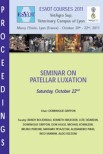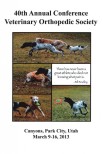Cat, male castrated, 5 years, presented with suspicious of HBC. Clinically the cat was in severe dyspnea, no localised pain was detected. X-rays of the thorax were taken. Left lateral projection of the thorax. The patient was considered not stable enough to take an orthogonal view. Radiologic findings
- There is an obvious, severe retraction of the lung parenchyma from the thoracic wall and the diaphragm, bilaterally. In the periphery of the thorax, no lung markings are visible.
- The cardiac silhouette is elevated from the sternum. The diaphragm is intact, all the abdominal organs are visible in situ in the cranial abdomen.
- The lung opacity is increased mainly cranial to the cardiac silhouette with a partial loss of definition of the lung vessels.
- There is a loss of continuity of the tracheal wall cranial to the bifurcation. The tracheal lumen is widened, there is a partial ‚tracheal stripe sign‘ of the ventral wall.
- There is an increased lucency of the cranial mediastinum, with increased visibility of the cranial vena cava.
- Skeletal structures within normal limits.
Radiographic diagnosis
- Severe bilateral pneumothorax.
- Penumomediastinum with tracheal rupture.
- Partial lung collaps DD lung contusion/hemorrhage.
Close up of the left lateral radiographs of the thorax: ‚Tracheal stripe sign‘ (short arrow), loss of contiguity of the tracheal wall (long arrows), CVC: cranial vena cava
- The cat was sent to surgergy for a thoracotomy.
- There was a circumferential lesion of the trachea app 1.5cm cranial to the bifurcation.
- The lesion was sutured and a chest drain was placed.
Comments
- Pneumomediastinum means free gas in the mediastinum, which provides excellent radiographic contrast against the soft tissue structures, resulting in increased conspicuity of the mediastinal organs.
- Anatomically the mediastinum is in direct communication with the retroperitoneum caudally and the connective tissue and muscular tissue of the neck cranially.
- Pneumomediastinum may progress to pneumothorax if mediastinal pressure results in tearing of the mediastinal pleura or if gas dissects through fenestrations in the mediastinal pleura. On the other hand, pneumothorax does not progress to pneumomediastinum.
- The ‚tracheal stripe sign‘ is the visibility of the outer tracheal wall secondary to the presence of gas lucency external to the trachea. The internal part of the tracheal wall is always visible, because the trachea lumen is normally filled with air. The differential diagnosis for presence of the tracheal stripe sign are pneumomediastinum or megaesophagus.
- Traumatic injury to the trachea is not very common in small animals but can result from bite wounds to the neck, gunshots, car accidents, compication of jugular venous puncture and, expecially in cats, secondary to overinflation of the endotracheal cuffs.
- Often a tracheal wall lesion will cause pneumomediastinum and subcutaneous emphysema, that can be severe.
- Radiographs may be anyway of limited use in the visualisation of the site of the tracheal or pharyngeal trauma: Unless an injury is disrupting the gross anatomy of the airways substantially as in a separation rupture of the cartilages, it is impossible to see tears on a survey radiographys. Sometimes the serosal layer and peritracheal soft tissues prevent a separation of the cartilage conspicuous enough to be visible on radiographs. In these cases the contribution of x-rays may be early detection of peritracheal air accumulation, pneumomediastinum, pneumothorax.
- The increased radiopacity of the lung parenchyma is primarily due to the high degree of atelectasis and then decreased volume of the lung. An underlying lung contusion or hemorrhage is possible but can not be proved unless radiographs are repeated with a better inflation of the lungs.









